
The circuit shown in the figure contains two diodes each with a forward resistance of $50\Omega $ and the infinite backward resistance. If the battery voltage is $\;6V$ , the current through the $100\Omega $ resistance ( in amperes ) is
(A) zero
(B) $\;0.02$
(C) $\;0.03$
(D) $\;0.036$
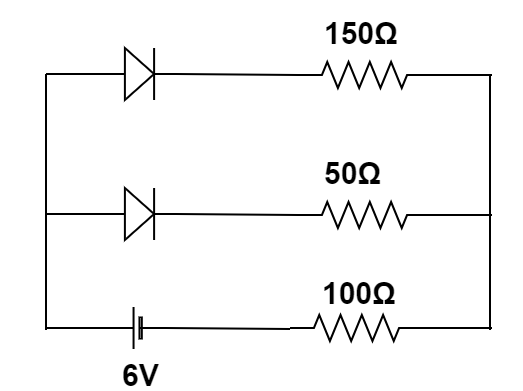
Answer
218.1k+ views
Hint: Knowledge of forward and reverse bias conditions for a PN junction diode is required. Given, the resistance of the diode will be $50\Omega $ in forward biasing condition and infinity in reverse biasing condition. Additionally, ohm’s law would also be required to find the current value.
Formula used:
$V = IR$
$ \Rightarrow I = \dfrac{V}{R}$
Complete Step-by-step solution: Let’s remake the circuit, by putting in the signs of the potential of the battery connected, the currents flowing through different arms of the circuit.
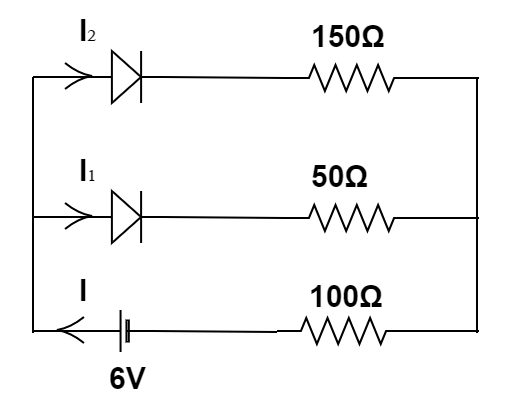
To understand the division of the current flowing through the circuit, we will use Kirchhoff's current law. Hence, considering the amount of current to be flowing through the resistance $100\Omega $ to be $I$ . Then, the circuit breaks into two arms. Hence, the current also gets divided into ${I_1}$ and ${I_2}$ .
Hence, the sum of ${I_1}$ and ${I_2}$ will be $I$ .
We will now discuss the diodes. A PN junction diode is a semiconductor containing excess electrons and holes on each end of the diode and a PN junction interface in between. A common region is formed between the P and the N side having equal amounts of holes and electrons.
In this case, both the diodes are in forward biased condition. Hence the resistance offered by the diode in a forward bias condition is $50\Omega $ .
Taking this into account,
The circuit can be simplified into this form
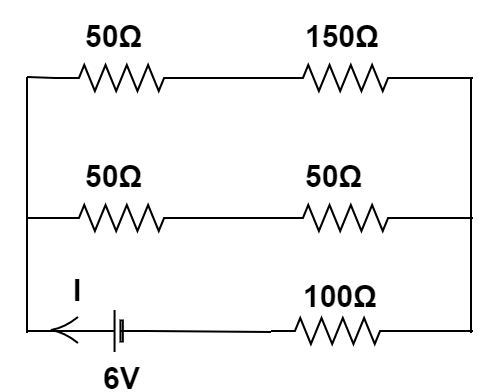
Therefore, we have to find the equivalent resistance of this circuit,
As $50\Omega $ resistor and $150\Omega $ resistor are in series. Therefore, the overall resistance of this arm is $200\Omega $ . Similarly, the overall resistance of the other arm is $100\Omega $ .
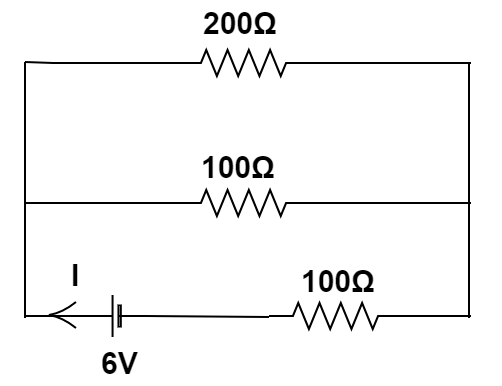
Since $200\Omega $ resistor and $100\Omega $ resistor are in parallel combination,
${R_{eq}} = \dfrac{{200 \times 100}}{{200 + 100}}$
$ \Rightarrow {R_{eq}} = \dfrac{{200 \times 100}}{{300}} = \dfrac{{200}}{3}$
Hence, the circuit can be simplified as;
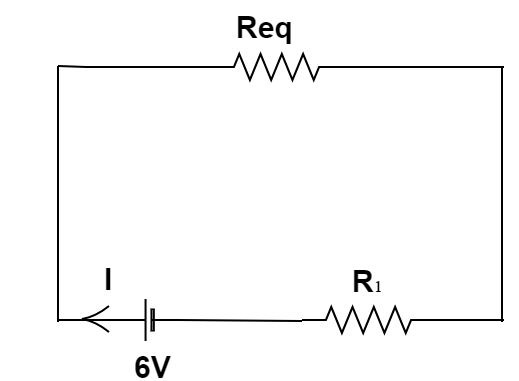
Therefore, the value of current flowing in the circuit can be found using ohm’s law:
$V = IR \Rightarrow 6V = I{R_{net}}$
$ \Rightarrow 6V = I\left( {{R_{eq}} + {R_1}} \right)$
On Substituting the value of ${R_{eq}}$ and ${R_1}$ in the above equation,
$ \Rightarrow 6V = I\left( {\dfrac{{200}}{3} + 100} \right)$
$ \Rightarrow 6V = I\left( {\dfrac{{500}}{3}} \right)$
Solve the above equation to determine the value of $I$ ,
$ \Rightarrow I = \dfrac{{6 \times 3}}{{500}} = \dfrac{9}{{250}}$
$ \Rightarrow I = 0.036A$
As a result, the amount of current flowing through the resistor $100\Omega $ is $\;0.036A$ .
Hence, the correct option is (D).
Note: we consider the value of the net resistance in the above condition to be: ${R_{net}} = {R_{eq}} + {R_1}$ because the resistances are in series to each other. The net resistance of the circuit, when the resistances are connected in series is given by the sum of the resistance values of the resistors connected.
Formula used:
$V = IR$
$ \Rightarrow I = \dfrac{V}{R}$
Complete Step-by-step solution: Let’s remake the circuit, by putting in the signs of the potential of the battery connected, the currents flowing through different arms of the circuit.

To understand the division of the current flowing through the circuit, we will use Kirchhoff's current law. Hence, considering the amount of current to be flowing through the resistance $100\Omega $ to be $I$ . Then, the circuit breaks into two arms. Hence, the current also gets divided into ${I_1}$ and ${I_2}$ .
Hence, the sum of ${I_1}$ and ${I_2}$ will be $I$ .
We will now discuss the diodes. A PN junction diode is a semiconductor containing excess electrons and holes on each end of the diode and a PN junction interface in between. A common region is formed between the P and the N side having equal amounts of holes and electrons.
In this case, both the diodes are in forward biased condition. Hence the resistance offered by the diode in a forward bias condition is $50\Omega $ .
Taking this into account,
The circuit can be simplified into this form

Therefore, we have to find the equivalent resistance of this circuit,
As $50\Omega $ resistor and $150\Omega $ resistor are in series. Therefore, the overall resistance of this arm is $200\Omega $ . Similarly, the overall resistance of the other arm is $100\Omega $ .

Since $200\Omega $ resistor and $100\Omega $ resistor are in parallel combination,
${R_{eq}} = \dfrac{{200 \times 100}}{{200 + 100}}$
$ \Rightarrow {R_{eq}} = \dfrac{{200 \times 100}}{{300}} = \dfrac{{200}}{3}$
Hence, the circuit can be simplified as;

Therefore, the value of current flowing in the circuit can be found using ohm’s law:
$V = IR \Rightarrow 6V = I{R_{net}}$
$ \Rightarrow 6V = I\left( {{R_{eq}} + {R_1}} \right)$
On Substituting the value of ${R_{eq}}$ and ${R_1}$ in the above equation,
$ \Rightarrow 6V = I\left( {\dfrac{{200}}{3} + 100} \right)$
$ \Rightarrow 6V = I\left( {\dfrac{{500}}{3}} \right)$
Solve the above equation to determine the value of $I$ ,
$ \Rightarrow I = \dfrac{{6 \times 3}}{{500}} = \dfrac{9}{{250}}$
$ \Rightarrow I = 0.036A$
As a result, the amount of current flowing through the resistor $100\Omega $ is $\;0.036A$ .
Hence, the correct option is (D).
Note: we consider the value of the net resistance in the above condition to be: ${R_{net}} = {R_{eq}} + {R_1}$ because the resistances are in series to each other. The net resistance of the circuit, when the resistances are connected in series is given by the sum of the resistance values of the resistors connected.
Recently Updated Pages
A square frame of side 10 cm and a long straight wire class 12 physics JEE_Main

The work done in slowly moving an electron of charge class 12 physics JEE_Main

Two identical charged spheres suspended from a common class 12 physics JEE_Main

According to Bohrs theory the timeaveraged magnetic class 12 physics JEE_Main

ill in the blanks Pure tungsten has A Low resistivity class 12 physics JEE_Main

The value of the resistor RS needed in the DC voltage class 12 physics JEE_Main

Trending doubts
JEE Main 2026: Application Form Open, Exam Dates, Syllabus, Eligibility & Question Papers

Derivation of Equation of Trajectory Explained for Students

Hybridisation in Chemistry – Concept, Types & Applications

Understanding the Angle of Deviation in a Prism

Understanding Collisions: Types and Examples for Students

Understanding Atomic Structure for Beginners

Other Pages
JEE Advanced Marks vs Ranks 2025: Understanding Category-wise Qualifying Marks and Previous Year Cut-offs

How to Convert a Galvanometer into an Ammeter or Voltmeter

Understanding Centrifugal Force in Physics

Ideal and Non-Ideal Solutions Explained for Class 12 Chemistry

Degree of Dissociation: Meaning, Formula, Calculation & Uses

Understanding Electromagnetic Waves and Their Importance




